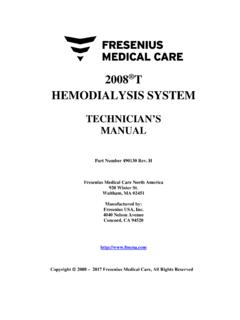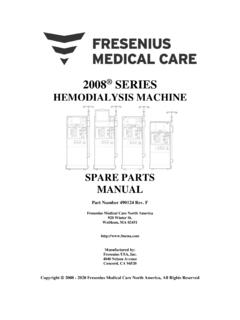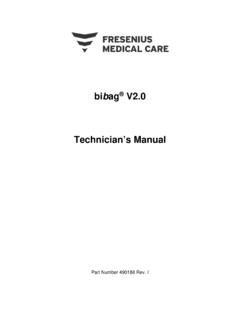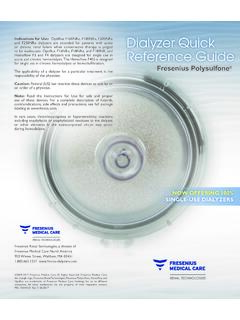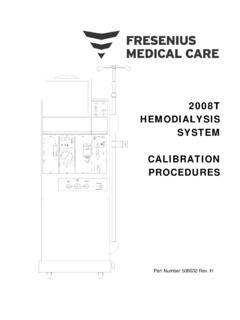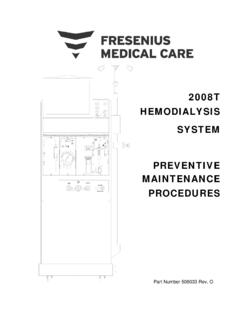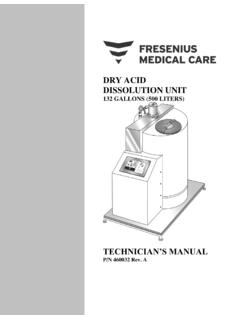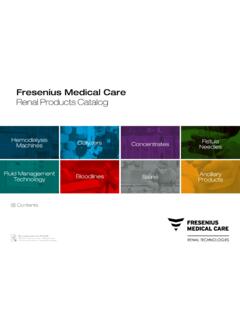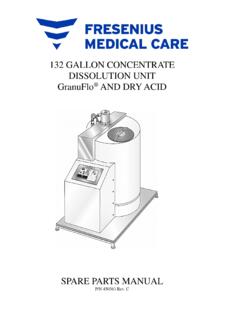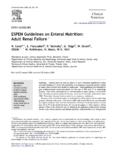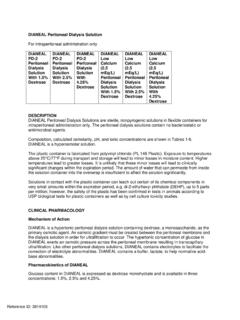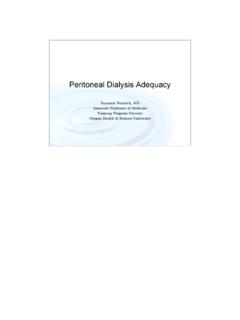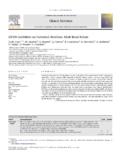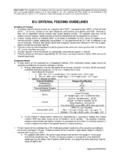Transcription of Peritoneal Dialysis Patient Guide - Fresenius Medical Care
1 Peritoneal DialysisPatient GuidePeritoneal DialysisPatient GuideImportant:Please refer to the Instructions For Use (IFU) for detailed information ondevice description,instructions,constraindicati on warnings and precautions. Peritoneal Dialysis Patient guidepage11. Introduction page 32. Normal Kidney Function page 43. Chronic Kidney Failure page 54. Common causes of Kidney Failure page 65. Understanding Peritoneal Dialysis page 7 Basic PrinciplesPeritoneal Peritoneal Dialysis Exchange page 10PD CatheterPD ExchangeDialysis SolutionAdding Medication to the Dialysis SolutionTypes of Peritoneal DialysisCAPDCCPDPD for Peritoneal Dialysis page 18 Aseptic TechniqueYour Work AreaGathering SuppliesWarming DialysateMasking and Hand WashingAdding MedicationsDisposing of Effluent and Used SuppliesHelpful Daily Routine page 25 Vital SignsBlood PressurePulseTemperatureWeightDaily Exit Site CareRecord KeepingContentsContentspage29.
2 Complications page 33 Infectious ComplicationsPeritonitisExitTunnelNon-In fectious ComplicationsFillingDrainingBlood-Tinged EffluentConstipationFluid OverloadDehydrationShoulder page 4111. nutrition page With Dialysis page 4913. Follow-up Care page 51 Clinic VisitsLab Dialysis Supplies page Questions page page 64 Peritoneal Dialysis Patient guideContentsContentspage3 The purpose of this Patient Guide is to present you withinformation about Peritoneal Dialysis (PD). Fresenius MedicalCare North America has prepared this manual as an aid to the excellent care offered by your Dialysis team which consistsof your doctor, nurse, dietitian and social will take a firm commitment from you to accept theresponsibility of carrying out your prescribed treatment planexactly as you have been taught. Besides learning how toperform Peritoneal Dialysis , you will learn how to recognizepotential problems and how to respond will also include taking your medications andfollowing your diet as Guide is just part of your free to make notesas you learn about will also find this to be a helpfulresource once you are home.
3 If you have any questions about the information in this manual, please ask your hometraining KidneysThe kidneys are two organs that are located in the lower back,one on each side of the are about the size of aclenched kidneys have numerous functions that arevital to your well main function is to rid the bodyof extra fluid and waste products. Everyone has waste productswhich result from digestion of kidneys filter thesewaste products and get rid of harmful waste through products are left in the kidneys help regulate the body s water alsorelease hormones which help make red blood cells and controlblood pressure. Another important balance that is affected bythe kidneys is calcium,phosphorus and vitamin D,which worktogether to play a key role in bone of the functions of the kidneys are to: Remove extra fluid Remove waste products Restore needed chemicals Regulate blood pressure Help red blood cell production Help with calcium and vitamin balancePeritoneal Dialysis Patient guideNormal Kidney FunctionNormal Kidney Functionpage5As kidney failure begins, the kidneys are not able to clean theblood of waste toxins and excess water collectin the body.
4 A build up of waste products in the blood is calleduremia. Some of the symptoms of kidney failure that you mightfeel include: Extreme tiredness Nausea and vomiting Difficulty sleeping Puffiness and swelling of the feet, legs,hands and face Shortness of breath Bad breath High blood pressureYou may experience all or one of these kidney failure means that the loss of kidney function is permanent. Kidney function may stop quickly or slowly failafter a number of years. End Stage Renal Disease or ESRD occurs when the kidneys have reached the point where theycan no longer work well enough to maintain the balancesneeded for is usually when Dialysis must be Kidney Failure (CKF)Chronic Kidney Failure (CKF)page6 There are many causes of kidney failure and a few of the mostcommon reasons are listed here: Diabetes Glomerulonephritis Pyelonephritis Lupus Erythematosus Hypertension Obstruction Polycystic Kidney Disease Structural DisordersDiabetes This causes blood vessel changes in the kidneys(and the whole body).
5 This process occurs over many kidney failure is caused by a thickening and hardening of renal arteries, glomeruli and This is the single most common causeof chronic kidney failure. In this disease there is inflammation anddestruction of the glomerulus in the Erythematosus Lupus is a chronic inflammatorydisease of the body tissue which causes scarringin the kidney leads to kidney This can occur with kidney stones. If urine isnot able to drain well and backs up into the kidneys, there canbe damage to the Kidney Disease In this condition, the kidneysare full of cysts that slowly enlarge then press against theworking parts of the kidney causing is aninherited This is an infection of the kidneys. Repeatedinfections may damage the nephrons causing kidney disorders This is from a defect in the is usually present at can cause urine toback up into the kidneys and cause Dialysis Patient guideCommon Causes of Kidney FailureCommon Causesof Kidney Failurepage7 Basic PrinciplesPeritoneal Dialysis (PD) is one of several ways to treat kidneyfailure.
6 PD is close to the natural function of the kidneys. It ridsthe body of waste products, extra fluid and helps balancechemicals in a slow and gentle order for Dialysis to take place, there must be a membranewith tiny holes (pores) to filter waste products from the membrane must be semi-permeable, meaning wasteproducts can pass through but the substances that your bodyneeds will Dialysis uses the Peritoneal membrane as an artificial kidney. This membrane also called the peritoneum is very thin and lines the abdominal cavity and covers mostof the internal peritoneum acts as the Peritoneal membrane has many small blood vessels(capillaries).When Dialysis solution is put into the peritonealcavity, waste products and excess fluid pass from the blood to the Dialysis processes that make this happenare osmosis, diffusion and Peritoneal DialysisUnderstanding Peritoneal Dialysispage8 OsmosisOsmosis is the process that allows excess water to beremoved from the osmosis, the body tries to makethe water balance on both sides of the willmove from an area that has the largest amount of water (least concentrated), to an area that has the smallest amount of water (the most concentrated).
7 Dialysis solution contains dextrose,a simple sugardraws excess fluid from the blood into the Dialysis blood will usually be less concentrated (have more waterand less dextrose) than the Dialysis means thatthe extra water in your blood will move across your peritonealmembrane into the Dialysis products and extra chemicals are removed from theblood through a process called Dialysis solutionhas no waste products and contains the proper amount the solution is put into the peritoneum, thewaste products and extra chemicals are drawn from the bloodinto the solution until they are equal. Once the blood anddialysis solution become equal, no Dialysis is taking example of this is to think of a cup that is divided by asemi-permeable membrane. On one side is water with a largeamount of salt (sodium).On the other side is solution thatcontains little salt particles on the concentrated sidewill slowly move to the side that has little there isthe same amount of salt on both sides of the membrane,themovement Dialysis Patient guideWaste productsExcess waterPeritoneal membranepage9 UltrafiltrationUltrafiltration means that an extra amount of water is done in PD by using Dialysis solution with anincreased concentration of dextrose, a type of moredextrose that is in the Dialysis solution, the more water thatwill be removed from your solution comes in three different strengths.
8 Dextrose dextrose dextroseDuring training, you will learn when you should use thedifferent strength PD CatheterTo fill and drain the Peritoneal cavity of solution, a soft plastictube called a catheter is inserted through the abdomen, into theperitoneum and sewn in catheter is placed by asurgeon or nephrologist in the operating room or specialtreatment room. It is a simple and short process. Once thecatheter has been placed,you may have a few days of discomfortwhere the opening was will have a large dressing over the site of Dialysis staff or a trained nurse at the doctor soffice will perform the first few dressing catheteris normally rested for a few days to a few weeks before using it for is needed to prevent the Dialysis solutionfrom doctor may order your catheter to be flushed during this time. A small amount of solution will be instilled (putthrough the catheter) into your Peritoneal cavity thenimmediately the catheter is healed,you will be instructed on how tocare for the catheter exit site (the skin around your catheter)by your Dialysis nurse.
9 He/she will instruct you on general exitsite care,bathing,swimming and securing the Dialysis Patient guideThe Peritoneal Dialysis ExchangeThe Peritoneal Dialysis ExchangeDrainpage11 The PD ExchangeAn exchange is the process of draining the Peritoneal cavityof old Dialysis solution, filling with the new solution, thenallowing it to are exchanging old Dialysis solutionwith new Dialysis solution. Let s take a closer look at theexchange process:Drain The fluid containing the waste and excess fluid isdrained can take approximately 15-20 Fresh solution is put into the Peritoneal cavity throughthe catheter. It usually takes 5-10 minutes to Dialysis occurs during the dwell fluid willstay in the Peritoneal cavity for a set number of will decide how many hours the fluid should the first few exchanges you may have a feeling of fullness when you fill. After a while, that feeling will go away and the feeling of fluid in your Peritoneal cavity will become doctor will determine how much fluid you will use duringeach exchange and how many exchanges you will do each doctor and nurse will help you make a schedule that willsuit your can continue your normal daily activitieswhile you carry the Dialysis solution within PD, youcan plan your Dialysis around your normal routines instead ofchanging your routine to suit your SolutionsDialysis solution is made up of: Sterile water Chemicals/electrolytes DextroseThere are several different strengths and bag sizes of doctor will decide which type and size is best for most common sizes are.
10 1 liter liter 2 liter liter 3 liters 5 liter (for cycling patients)The solution bag has a dextrose percentage (%) numberprinted on higher the number, the more dextrose(sugar) there is in the bag and the stronger the solution is. solution has the lowest amount of sugar and is usuallyused by patients who gain a small amount of fluid weight. solution is usually used by patients who gain 2-3 pounds of fluid over their dry weight. solution has the highest amount of sugar and is usuallyused by patients who gain more than 3 pounds of fluid overtheir dry strength of solution that you use will depend on theamount of extra water that needs to be greaterthe amount of extra fluid that needs to be removed from yourbody, the higher the percent of solution you should Dialysis Patient guidepage13 The following are examples of what a two liter bag of solution might remove: dextrose removes about 100-300cc of extra fluid dextrose removes about 300-500cc of extra fluid dextrose removes about 600-800cc of extra waterYour doctor and PD nurse will instruct you in the selection ofthe best Dialysis solution for is based on your weight,blood pressure and according to your symptoms and responseto the Dialysis therapy.
